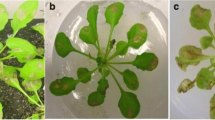Abstract
All these hosts became less susceptible as the plants matures. Ascospores were unable to infect linseed leaves in the absence of an exogenous nutrient base. Even though sucrose could be used as an exogenous nutrient to stimulate the ascospores to germinate, the ascospores subsequently failed to infect undamaged linseed leaves. Linseed flower petals were an effective nutrient base which stimulated ascospores to germinate as well as to infect undamaged linseed leaves.
Similar content being viewed by others
References
ABAWI, G. S. & GROGAN, R. G. 1975a. Source of primary inoculum and effects of temperature and moisture on infection of beans byWhetzelinia sclerotiorum. Phytopathology.65, 300–309.
Abawi, G. S., Polach, F. J. & Molin, W. T. 1975b. Infection of bean by ascospores ofWhetzelinia sclerotiorum. Phytopathology.65, 673–678.
Blanchette, P. S. & Auld, D. L. 1978. Screening field pea for resistance to white mold. Crop Science.18, 977–979.
Boland, G. J. & Hall, R. 1986. Growthroom evaluation of soybean cultivars for resistance toSclerotinia sclerotiorum. Can. J. Plant Sci.66, 559–564.
BOLAND, G. J. & HALL, R. White mold of soybeans. Can. J. Plant Pathol. 1982,4 304.
Chen Yongkang. 1960. Applying Chen Yongkang rice cultivation technique of “three yellow three black” to control blast of rice. Beijing Agricultural University.
GRAINGER, J. 1956. Host nutrition and attack by fungal parasites. Phytopath.46, 445–456.
Grau, C. R., Radke, V. L. & Gillespie, F. L. 1982. Resistance of soybean cultivars toSclerotinia sclerotiorum. Plant Disease.66(6): 506–508.
Grau, C. R. & Radke, V. L. 1984. Effects of cultivars and cultural practices onSclerotinia stem rot of soybean. plant Disease.68, (1) 56–58.
Hine, R. B. & Wheeler, J. E. 1970. The occurrence of some previously unreported diseases in Arizona. Plant Disease Report.54, 179–180.
Hunter, J. E., Dickson, M. H. & Cigna, J. A. 1981. Limited-term inoculation: a method to screen bean plants for partial resistance to white mold.65(5) 414–417.
Jellis, G. J., Davies, J. M. L. & Scott, E. S. 1984.Sclerotinia on oilseed rape: implications for crop rotation. British Crop Protection Conference-Pest and Disease.8A-1, 709–715.
Li Han Qing & Fu Chun Yan. 1981. Studies on the selerotinial rot of soybean. Acta phytopathologica Sinica.11 No. 3 19–24.
MADJID, A., HONMA, S. & LACY, M. A greenhouse method for screening lettuce for resistance toSclerotinia sclerotiorum. Scientia Horticulturae 1982/83,18, 201–206.
Mclean, D. M. 1958. Role of dead flower parts in infection of certain crucifers bySclerotinia sclerotiorum (Lib.) de Bary. plant Disease Reporter.42, 663–666.
Mitchell, S. J., Jellis, G. J. & Cox, T. W. 1986.Sclerotinia sclerotiorum, on linseed. plant pathology.35, 403–405.
Newton, H. C. & Sequeira, L. 1972., Ascospores as the primary infective propagule ofSclerotinia sclerotiorum in Wisconsin. plant Disease Reporter.56, 798–802.
Pethybrige G. H., Lafferty H. A. & Rhynehart J. G. 1921. Investigations on flax disease. Journal of the Department of Agriculture, Ireland21, 167–187.
Purdy, L. H. & Bardin, R. 1953. Mode of infection of tomato plants by the ascospores ofSclerotinia sclerotiorum. Plant Disease Reporter.37, 361–362.
Sedun, F. S. & Brown, J. F. 1987. Infection of sunflower leaves by ascospores ofSclerotinia sclerotiorum. Ann. appl. Biol.110, 275–285.
Sutton, D. C. & Deverall, B. J. 1983. Studies on infection of bean (Phaseolus vulgaris) and soybean (Glycine max) by ascospores ofSclerotinia sclerotiorum. Plant Pathology.32, 251–261.
Willetts, H. J. & Wong, A. L. 1980. The biology ofSclerotinia sclerotiorum, S. trifoliorum andS. minor with emphasis on specific nomenclature. Botanical Review.46(2), 101–165.
Yang, Q. 1996. The relationship between the growth stages of soybean and their susceptibilities toSclerotinia sclerotiorum. Journal of King Mongkut's Institute of Technology. Ladkrabang.8(1), 1–6.
Author information
Authors and Affiliations
Additional information
(Responsible: Editor: Sun Yueqi).
Rights and permissions
About this article
Cite this article
Qian, Y., Ling, M. Influence of host on behavior ofSclerotinia sclerotiorum . Journal of Forestry Research 8, 43–46 (1997). https://doi.org/10.1007/BF02864940
Issue Date:
DOI: https://doi.org/10.1007/BF02864940




